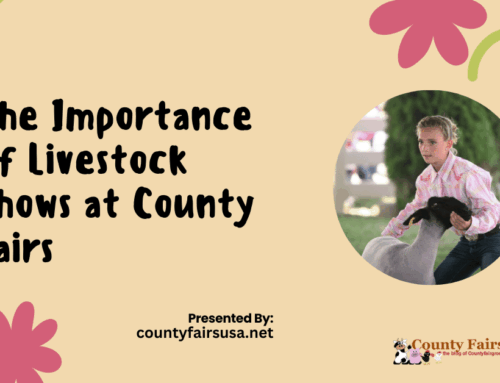Beneath the cheerful canopies and vibrant displays of a typical American county fair lies a powerful economic engine that sustains local agriculture and craftsmanship. These annual gatherings numbering over 2,000 across the United States draw more than 150 million visitors yearly, creating vital marketplaces where small producers connect directly with consumers.
County Fairs Support Local Farmers & Artisans
While many associate fairs primarily with entertainment, their historical purpose and continued significance revolve around showcasing and supporting local farmers and artisans.
This guide explores the multifaceted ways these community celebrations strengthen local economies, preserve cultural traditions, and create sustainable pathways for small-scale producers to thrive in an increasingly globalized marketplace.
The Historical Connection Between County Fairs and Local Agriculture
County fairs trace their origins to early 19th century America, when communities would gather to display livestock, produce, and homemaking skills. The first recognized American agricultural fair took place in Pittsfield, Massachusetts in 1811, organized by Elkanah Watson to improve farming practices through competition and education.
What began as simple livestock exhibitions gradually expanded to include:
- Agricultural demonstrations and competitions
- Home economics displays
- Entertainment and carnival attractions
- Community celebrations of local culture
Throughout their evolution, county fairs have maintained their core mission of supporting agricultural communities. The Dutchess County Fair in New York, for instance, has operated since 1842 and continues to highlight local farming achievements while drawing over 300,000 visitors annually.
“County fairs represent one of America’s longest-standing traditions of public support for local food systems,” notes Dr. Sarah Jenkins, agricultural historian at Cornell University. “They create spaces where rural production receives recognition and celebration, something increasingly important in our globalized food economy.”
Economic Benefits for Local Farmers
For many small-scale agricultural producers, county fairs deliver substantial economic advantages that extend well beyond the event itself.
Direct Sales Opportunities
County fairs provide concentrated marketplace access, allowing farmers to reach thousands of potential customers in a short timeframe. According to a 2023 survey by the International Association of Fairs and Expositions, agricultural vendors report average gross sales of $3,500-$7,000 during a typical county fair week representing significant revenue for small farm operations.
For James Wilson, a fourth-generation apple grower from Pennsylvania, fair participation accounts for nearly 15% of his annual income. “We make connections at the county fair that turn into year-round customers,” Wilson explains. “People remember tasting our apples at the fair and seek out our stand at farmers’ markets afterward.”
Marketing and Exposure Benefits
County fairs function as powerful marketing channels, particularly for producers with limited advertising budgets. The exposure includes:
- Face-to-face interactions with potential customers
- Product sampling opportunities
- Media coverage and public visibility
- Building brand recognition through competition awards
When Riverdale Organic Dairy won “Best in Show” at their county fair dairy competition, their local retail sales increased by 27% in the following quarter demonstrating how fair recognition translates to commercial success.
Networking and Professional Development
Beyond consumer connections, fairs facilitate valuable professional relationships:
County fairs create environments where farmers can exchange knowledge about growing techniques, market trends, and business strategies. These informal mentorship opportunities prove especially valuable for beginning farmers, who might otherwise struggle to access accumulated agricultural wisdom.
The Midwest Farmers Cooperative traces its origins to relationships formed during the 1978 Johnson County Fair, where five family farms discovered they could improve their market position by working together. Today, the cooperative includes 47 member farms and generates over $12 million in annual revenue.
Showcasing Artisanal Crafts and Products
Alongside agricultural exhibits, county fairs provide crucial venues for artisans practicing both traditional and contemporary crafts.
Diverse Maker Representation
Modern county fairs typically feature artisans specializing in:
- Woodworking and furniture making
- Textile arts including quilting, weaving, and fiber crafts
- Ceramics and pottery
- Metalwork and blacksmithing
- Soap and candle making
- Food preservation and specialty foods
- Jewelry and decorative arts
For Emma Chen, who creates hand-thrown pottery in rural Oregon, county fairs offered her first opportunity to display work to a broader audience. “Online sales are important, but nothing compares to watching someone hold your piece and connect with it,” Chen says. “County fairs gave me confidence my work had market appeal before I invested in more expensive art shows.”
The Power of Demonstration
Unlike static retail environments, county fairs allow artisans to demonstrate their processes, adding educational value and appreciation for craftsmanship. When visitors witness blacksmiths forging metal or weavers working at looms, they develop deeper understanding of the skill and time invested in handmade goods.
A 2024 study from the American Craft Council found that consumers who observed craft demonstrations were willing to pay 35% more for handmade items compared to those who simply viewed finished products illustrating how education impacts perceived value.
Building Community Connections and Support Networks
County fairs strengthen agricultural communities by fostering relationships between producers who might otherwise remain isolated.
The concentrated gathering of agricultural practitioners creates natural opportunities for:
- Sharing innovative solutions to common challenges
- Discussing regional growing conditions and adaptations
- Comparing notes on equipment and techniques
- Coordinating complementary businesses
“Before participating in county fairs, I farmed in relative isolation,” explains Maria Gonzalez, who grows specialty peppers in New Mexico. “Through connections made at our fair, I joined a seed-saving collective and found partners for equipment sharing that makes all our operations more sustainable.”
These relationships often extend beyond the fairgrounds. The Central Valley Producer Alliance which now includes over 200 small farmers and advocates for favorable agricultural policies began with informal conversations between vendors at the San Joaquin County Fair in 2019.
Educational Impact for Future Generations
County fairs play a vital role in agricultural education, particularly through youth organizations like 4-H and Future Farmers of America (FFA).
Youth Development Programs
These structured programs teach young people responsibility and practical skills through:
- Raising and showing livestock
- Growing competition-quality produce
- Developing business plans for agricultural enterprises
- Public speaking and presentation skills
Emily Johnson, who began showing chickens at age nine through her local 4-H club, now manages a sustainable poultry operation with 500 heritage-breed birds. “My county fair experiences shaped my entire career path,” Johnson reflects. “I learned about poultry genetics, business management, and public engagement all through 4-H competitions.”
Bridging Urban-Rural Divides
As America becomes increasingly urbanized, county fairs provide crucial opportunities for children with limited exposure to agriculture to understand food systems. Interactive exhibits like “Farm to Fork” demonstrations help young people connect the dots between farming and their daily meals.
A 2023 survey of urban school groups visiting county fairs found that 78% of children could better explain where food comes from after their visit, compared to just 31% before attending.
Modern Challenges and Adaptations
While maintaining their traditional core, county fairs have evolved to address contemporary challenges and opportunities.
Digital Integration
Forward-thinking county fairs now incorporate technology to extend their impact:
- Virtual tours for those unable to attend in person
- Social media promotion for vendors before and after events
- QR codes linking to producer websites and online stores
- E-commerce platforms for year-round sales between fairs
The Nebraska State Fair pioneered a “Digital Marketplace” connecting fair visitors with exhibitors throughout the year, resulting in a 47% increase in post-fair sales for participating vendors.
Focus on Sustainability
Many county fairs now emphasize environmental stewardship through:
County fairs increasingly highlight sustainable farming practices through dedicated exhibition spaces and awards. The Green Acres pavilion at the Washington County Fair showcases regenerative agriculture, attracting sponsors and connecting eco-conscious consumers with compatible producers.
Waste reduction initiatives have become standard at progressive fairs, with the Iowa State Fair‘s composting program diverting over 12 tons of food waste annually while creating educational opportunities about soil health.
Conclusion: The Enduring Value of County Fairs
Despite changing times, county fairs remain vital institutions supporting local producers. By creating marketplaces, facilitating knowledge exchange, educating consumers, and fostering community connections, these events deliver multilayered benefits for farmers and artisans.
As consumers increasingly seek authentic connections to their food and goods, county fairs offer transparent glimpses into local production systems. They serve as living museums of agricultural heritage while simultaneously showcasing innovations shaping our future food landscape.
For communities seeking to strengthen local economies and preserve agricultural traditions, supporting county fairs represents a practical investment with far-reaching returns. Whether you’re a producer looking to grow your business or a consumer interested in supporting local systems, your county fair offers a direct path to engagement with the people and processes behind our essential goods.
The next time you visit your local county fair, look beyond the midway attractions to appreciate the complex ecosystem of support these events provide to the farmers and artisans who feed and furnish our communities with care and craftsmanship.
Follow Us on Facebook!








Leave A Comment